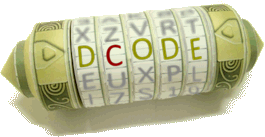Tool to convert bibi-binary numbers. Bibi-binary (or bibinary or bibi code) is a numeric system invented by Boby Lapointe in order to represent numbers in letters which pronunciation seems funny.
Bibi-binary Code - dCode
Tag(s) : Arithmetics, Fun/Miscellaneous
dCode is free and its tools are a valuable help in games, maths, geocaching, puzzles and problems to solve every day!
A suggestion ? a feedback ? a bug ? an idea ? Write to dCode!
Bibi-binary Code
Bibi-binary to dEcimal Code Decoder/Converter
Decimal to Bibi-binary Code Encoder/Converter
Answers to Questions (FAQ)
How to convert to Bibi-binary code?
Take a number (in base 10) and convert to base 16 (hexadecimal) before replacing each character its BiBibinary value in the table:
| Hexa | Bibi | Hexa | Bibi |
|---|---|---|---|
| 0 | HO | 1 | HA |
| 2 | HE | 3 | HI |
| 4 | BO | 5 | BA |
| 6 | BE | 7 | BI |
| 8 | KO | 9 | KA |
| a | KE | b | KI |
| c | DO | d | DA |
| e | DE | f | DI |
Example: 123 in base 10 is written 7b in base 16 and 7=BI and b=KI so 123=BIKI
How to convert/decrypt the Bibi-binary code?
Each group of 2 letters is replaced by its equivalent in base 16.
| Bibi | Hexa | Bibi | Hexa |
|---|---|---|---|
| HO | 0 | HA | 1 |
| HE | 2 | HI | 3 |
| BO | 4 | BA | 5 |
| BE | 6 | BI | 7 |
| KO | 8 | KA | 9 |
| KE | a | KI | b |
| DO | c | DA | d |
| DE | e | DI | f |
Remains to convert to base 10 each number obtained in base 16.
Example: DEKODE=e8e in base 16 is equal to 3726 in base 10.
How to recognize Bibi-binary code?
The message is only composed of syllables de,da,do,di,be,ba,bo,bi,ke,ka,ko,ki,he,ha,ho,hi.
What is Bibi-binary notation?
Symbols have been associated to syllables 
Why the name Bibi-binary?
Boby Lapointe described BiBi-binary as a short binary code. Citations (translated):
With the binary code, with 4 digits, get up to 15. With BiBi-binary, get up to 15 ... with 2 letters. [...] In argot bibi means me, my name is Boby and my children call me bibi so it is fun to call this system Bibi. [...] Binary is a base 2 system, bibinary is a base 4 system, bibi-binary is a base 16 system.
Base 4 or Base 16 for Bibi-binary?
BiBi-binary uses 8 characters: 4 vowels O, A, E, I and 4 consonants H, B, K et D. So it is not exactly a base 4 numeric system, but, depending on the parity (odd/even) it uses a vowel or a consonant. This subtlety supports that it is a base 16 writing (hexadecimal).
How to convert binary to Bibi-binary?
Segment the binary code in groups of 2 (from the right)
Example: 110111001 becomes '01, 10,11,10,01 '
Always starting from the right, replace the first group with vowels then the next group with consonants and so on alternately according to the table:
| 00 | O | H |
| 01 | A | B |
| 10 | E | K |
| 11 | I | D |
Example: '01, 10,11,10,01 becomes AKIKA', if the number of letters is not even, complete with an initial H or HAKIKA
When Bibi-binary code was invented ?
A patent has been set in 1968 by Robert Lapointe.
Source code
dCode retains ownership of the "Bibi-binary Code" source code. Any algorithm for the "Bibi-binary Code" algorithm, applet or snippet or script (converter, solver, encryption / decryption, encoding / decoding, ciphering / deciphering, breaker, translator), or any "Bibi-binary Code" functions (calculate, convert, solve, decrypt / encrypt, decipher / cipher, decode / encode, translate) written in any informatic language (Python, Java, PHP, C#, Javascript, Matlab, etc.) or any database download or API access for "Bibi-binary Code" or any other element are not public (except explicit open source licence). Same with the download for offline use on PC, mobile, tablet, iPhone or Android app.
Reminder: dCode is an educational and teaching resource, accessible online for free and for everyone.
Cite dCode
The content of the page "Bibi-binary Code" and its results may be freely copied and reused, including for commercial purposes, provided that dCode.fr is cited as the source (Creative Commons CC-BY free distribution license).
Exporting the results is free and can be done simply by clicking on the export icons ⤓ (.csv or .txt format) or ⧉ (copy and paste).
To cite dCode.fr on another website, use the link:
In a scientific article or book, the recommended bibliographic citation is: Bibi-binary Code on dCode.fr [online website], retrieved on 2025-11-07,
- Bibi-binary to dEcimal Code Decoder/Converter
- Decimal to Bibi-binary Code Encoder/Converter
- How to convert to Bibi-binary code?
- How to convert/decrypt the Bibi-binary code?
- How to recognize Bibi-binary code?
- What is Bibi-binary notation?
- Why the name Bibi-binary?
- Base 4 or Base 16 for Bibi-binary?
- How to convert binary to Bibi-binary?
- When Bibi-binary code was invented ?
